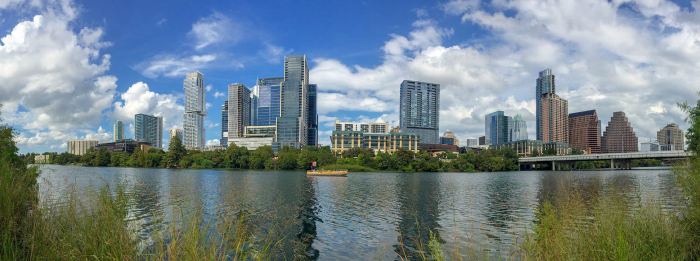Austin Time, a symphony of timekeeping, is a captivating exploration into the cultural, economic, and technical aspects that shape the rhythm of this vibrant city. Its unique blend of Central Time and daylight saving time weaves a tapestry of daily life, influencing everything from business hours to artistic expression.
Delving deeper, we uncover the historical roots of Austin Time, its impact on local culture and events, and its undeniable connection to the city’s distinct “Austin vibe.” We’ll also examine the economic implications for businesses and tourism, as well as the technical intricacies of timekeeping in Austin, including the role of atomic clocks and time servers.
Austin Time Overview

Austin, the capital of Texas, observes Central Time (CT), which is six hours behind Coordinated Universal Time (UTC). Central Time is one of the six time zones in the United States, and it is used in the central region of the country, including Texas.
During the summer months, Austin observes daylight saving time (DST), which means that clocks are moved forward one hour. This occurs on the second Sunday of March, and clocks are moved back one hour on the first Sunday of November. DST is used to make better use of daylight hours, and it can help to save energy.
Impact of Daylight Saving Time on Austin Time
When DST is in effect, Austin time is one hour ahead of Central Standard Time (CST). This can be confusing for travelers, as they may need to adjust their clocks when they enter or leave the Austin area. It is important to note that not all states in the United States observe DST, so it is important to check the time zone of your destination before you travel.
Cultural Significance of Austin Time
Austin time, characterized by its relaxed and informal nature, plays a significant role in shaping the local culture and daily life in Austin, Texas.
The “Austin vibe,” a unique blend of creativity, eccentricity, and laid-back attitude, is often attributed to the city’s time zone. The slower pace of life, influenced by the absence of daylight saving time, allows for a more relaxed and flexible approach to time.
Events and Gatherings
Austin time is evident in the city’s numerous cultural events and gatherings. For instance, the renowned South by Southwest (SXSW) festival, known for its music, film, and technology exhibitions, embraces the city’s relaxed time zone. Attendees can enjoy extended performances, late-night screenings, and impromptu gatherings without feeling rushed.
Business and Daily Life
The influence of Austin time extends to business and daily life. Flexible work hours and a casual dress code are common in the city’s tech and creative industries. Residents often prioritize personal time and social connections over strict schedules.
Austin’s culinary scene also reflects the city’s relaxed time zone. Restaurants and food trucks offer extended hours, allowing diners to enjoy leisurely meals and late-night snacks.
Social Interactions, Austin time
Austin time fosters a sense of community and encourages social interactions. Locals value face-to-face connections and often engage in extended conversations at coffee shops, parks, and social gatherings. The slower pace of life allows for meaningful conversations and a genuine connection with others.
Economic Impact of Austin Time
Austin time, as a unique and non-standard time zone, has significant economic implications for businesses and the tourism industry. Its impact on business hours and operations, as well as its influence on tourism and travel, are notable aspects to consider.
Impact on Business Hours and Operations
Austin time’s deviation from Central Standard Time (CST) has implications for business hours and operations. Many businesses in Austin adjust their schedules to align with the local time, resulting in later start and end times. This shift accommodates the city’s unique lifestyle and allows for a more balanced work-life integration.
- Extended Business Hours: Austin businesses often operate with extended hours to cater to the later start times. This allows employees to better manage their work-life balance and engage in personal activities during the early hours of the day.
- Flexible Work Arrangements: Austin’s non-standard time zone promotes flexible work arrangements, enabling employees to adjust their work schedules to accommodate personal commitments and preferences.
Impact on Tourism and Travel
Austin time’s distinction from other time zones influences tourism and travel patterns. Its unique time zone creates a perceived time difference for visitors coming from different parts of the country.
- Increased Tourism Revenue: Austin’s unique time zone attracts tourists who seek a different experience and a slower pace of life. The later sunset times allow for extended outdoor activities and nightlife, contributing to increased tourism revenue.
- Tourism Promotion: Austin’s time zone is often highlighted as a unique feature in tourism promotional campaigns, attracting visitors who desire a break from the standard time zones.
Overall, Austin time has a multifaceted economic impact, affecting business operations, tourism patterns, and the city’s overall economic vitality. Its unique time zone contributes to Austin’s distinct character and enhances its appeal as a vibrant and dynamic destination.
Technical Aspects of Austin Time

Timekeeping in Austin is governed by the precise mechanisms of atomic clocks and time servers. These instruments ensure the accuracy and reliability of Austin time, enabling the smooth functioning of daily life and various industries.
Atomic Clocks
Atomic clocks are highly accurate timekeeping devices that utilize the natural vibrations of atoms to measure time. These clocks are the primary reference for timekeeping worldwide, including in Austin. They provide an extremely stable and precise time signal, with an accuracy of a few nanoseconds per day.
Time Servers
Time servers are computers that receive time signals from atomic clocks and distribute them over networks. In Austin, time servers are operated by various organizations, including the University of Texas at Austin and the National Institute of Standards and Technology (NIST). These servers provide a reliable and easily accessible source of accurate time for computers and other devices.
Austin time is well-known for its eclectic live music scene, but it’s also home to some beautiful historical landmarks. One of the most impressive is the bath abbey , a stunning example of Gothic architecture. The abbey was founded in the 7th century and has been a major religious and cultural center ever since.
Today, it’s a popular tourist destination and a must-see for anyone visiting Austin.
Accuracy and Reliability
The combination of atomic clocks and time servers ensures the accuracy and reliability of Austin time. The atomic clocks provide a highly precise reference, while the time servers distribute this signal widely, making it accessible to various users. As a result, Austin time is highly reliable and can be used with confidence in applications that require accurate timekeeping.
Austin Time and Technology

Austin time plays a significant role in various technological applications. It serves as a crucial reference point for time-sensitive operations and ensures seamless communication and coordination in a globalized world.
Role of Time Zones in GPS and Navigation Systems
Global Positioning Systems (GPS) and navigation systems rely on accurate timekeeping to determine a receiver’s location. The time difference between the GPS satellite’s atomic clock and the receiver’s clock, along with the speed of light, allows for precise distance calculations and navigation.
Impact of Austin Time on Online Scheduling and Communication
In the digital age, Austin time serves as a common denominator for online scheduling and communication. It facilitates the coordination of virtual meetings, appointments, and events across different time zones. Tools like calendar apps and video conferencing platforms utilize Austin time to ensure that participants from diverse locations can align their schedules effectively.
Austin Time and Health
The implementation of Austin time, with its unique time zone and daylight saving time (DST) practices, has potential implications for the health and well-being of individuals residing in the region. Understanding these implications and implementing strategies to mitigate potential negative effects is crucial for maintaining optimal sleep patterns and overall health.
Effects of Daylight Saving Time on Sleep Patterns
DST, a key component of Austin time, involves shifting clocks forward by one hour in the spring and back by one hour in the fall. This adjustment can disrupt the body’s natural circadian rhythm, which regulates sleep-wake cycles. Studies have shown that DST can lead to:
- Reduced sleep duration
- Increased sleep latency (time taken to fall asleep)
- Increased daytime sleepiness
These disruptions can have negative consequences for cognitive function, mood, and overall health.
Recommendations for Optimizing Sleep and Well-being
To minimize the potential negative effects of Austin time on sleep and well-being, individuals can adopt the following strategies:
- Maintain a consistent sleep-wake schedule, even on weekends.
- Create a relaxing bedtime routine to promote sleep.
- Avoid caffeine and alcohol before bed.
- Ensure the bedroom is dark, quiet, and cool.
- Consider using blackout curtains or a sleep mask to block out light.
- Get regular exercise, but avoid working out too close to bedtime.
- Seek professional help if experiencing persistent sleep problems.
By following these recommendations, individuals can optimize their sleep and well-being while living in the Austin time zone.
The bustling city of Austin, Texas, boasts a vibrant and lively atmosphere that extends to its iconic outdoor spaces. One such gem is Albert Park , a sprawling green oasis located in the heart of the city. Whether you’re seeking a leisurely stroll, a refreshing picnic, or a scenic backdrop for a gathering, Albert Park offers a serene escape from the hustle and bustle of Austin time.
Austin Time and Education

Austin time has a significant impact on the educational landscape of the city. From school schedules to extracurricular activities, time plays a crucial role in shaping the learning experience for students.
One of the challenges of teaching time concepts in Austin is the unique way in which time is perceived and measured. The relaxed and laid-back atmosphere of the city can lead to a more fluid understanding of time, making it difficult for students to grasp the concept of punctuality and time management.
Innovative Approaches to Time Management in Education
To address these challenges, educators in Austin have developed innovative approaches to time management in the classroom. One such approach is the use of visual aids, such as timetables and clocks, to help students visualize the passage of time.
Another approach is the incorporation of real-world examples into the curriculum. By connecting time concepts to everyday activities, students can better understand the practical applications of time management.
Additionally, schools in Austin often offer extracurricular activities that focus on time management skills. These activities, such as sports and music, provide students with opportunities to practice planning, scheduling, and working within time constraints.
If you’re an Austin local looking for a unique way to spend your free time, why not try scuba diving? There are plenty of great scuba diving locations within a short drive of the city. And with Austin’s warm climate, you can enjoy diving year-round.
So what are you waiting for? Dive in and explore the underwater world!
Austin Time and the Arts
Austin time has a profound impact on the city’s arts scene. The city’s relaxed and laid-back atmosphere fosters a creative environment where artists feel free to experiment and take risks. The city’s vibrant live music scene is a testament to the influence of Austin time. Many of the city’s most popular music venues are open late, allowing musicians to perform and audiences to enjoy live music well into the night.
Timing of Performances and Events
The timing of performances and events in Austin is often influenced by the city’s relaxed timekeeping. Concerts and other events often start later than scheduled, and audiences are typically more tolerant of delays. This relaxed approach to time allows artists to take their time and create a more immersive experience for their audiences.
Incorporation of Time into Art
Many Austin artists incorporate time into their work in unique and innovative ways. For example, the artist Trenton Doyle Hancock has created a series of paintings that explore the concept of time travel. The paintings depict figures that are frozen in time, or that are moving through time in a non-linear fashion. Hancock’s work challenges traditional notions of time and invites viewers to consider the different ways that time can be experienced.
End of Discussion

As we conclude our exploration of Austin Time, we recognize its profound influence on various aspects of life within this bustling metropolis. From education to the arts, from health to technology, Austin Time serves as an integral thread connecting the city’s past, present, and future. Its unique rhythm continues to inspire and shape the dynamic tapestry of Austin, making it a city that truly lives by its own time.
Essential FAQs
What is the time difference between Austin and New York City?
During Standard Time, Austin is 1 hour behind New York City. During Daylight Saving Time, Austin is 2 hours behind New York City.
Does Austin observe Daylight Saving Time?
Yes, Austin observes Daylight Saving Time from March to November.
How does Daylight Saving Time affect Austin’s sleep patterns?
Daylight Saving Time can disrupt sleep patterns, as it involves shifting the clock forward by 1 hour in the spring and back by 1 hour in the fall.